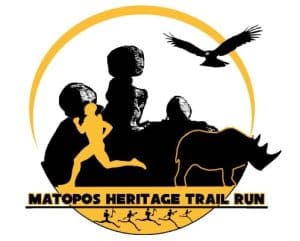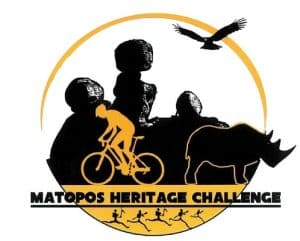1 – ANNUAL GENERAL MEETING
It’s time for the Society to gather once again for its annual Indaba. Despite the impact of the Coved 19 Lockdown, the Society has been surprisingly active. Please show your support by attending the AGM.
Nominations for the Society Committee are both sought and appreciated!
2 – ORCHIDS FOR SALE
During October, National Parks raided the vendors who were illegally selling indigenous plants at Bradfield. By this time, aloes and tree ferns had joined the orchids for sale – all specially protected plants, and quite certainly illegally collected. The vendors were not apprehended, but the plants were recovered and to date the illegal practice has not returned.
3 – RAINFALL
We enjoyed some early rain in August during which 18mm was recorded. Then in early October we enjoyed some good rain with as much 53mm, and again during the week that the Newsletter is written. Not yet the main rains. But healthy start that has left the hills vibrantly green and given us all some hope. Rainfall to date
Eastern Matopos 107mm; Central Matopos 100mm; Western Matopos 115mm; Bulawayo 97mm.
4 – NSWATUGI SITE MUSEUM
As reported over a year ago, the site museum at Nswatugi Cave burnt down in a veldt fire. In consultation with Museums it was agreed not to rebuild the thatch structure, so instead panels were prepared with the same information. In October, the MCS with the assistance of Camp Dwala and Rowallan Adventure Park, moved on site and demolished the old museum. The bricks were then used to erect Blair toilets (a much-needed facility given the volume of visitors to the site). Parts of the walls were left as benches and the new panels erected. Work is also going to be done on the approach road to repair damage.
So once again, the MCS has stepped in to assist NMMZ at Nswatugi Cave, and so provided a useful visitor feature. Further work may be required in due course but this is a great step forward.
Members may recall that last year NMMZ carried out rehabilitation work inside the cave itself, providing much needed protection to both the paintings and the deposit.
Consequently, we felt it appropriate to carry an article in this Newsletter on Dr Neville Jones who did so much archaeological work at this cave in 1932 (having first recorded it 98 years ago in 1922).
5 – INANGE CAVE
Seven members took up the call for volunteers and ventured out to Toghwana on Saturday 14th November. After a necessary cup of tea, rucksacks were packed with lunch and paint, and the task began at 10:00am – to repaint the arrows from Toghwana dam to Inange cave – a mere 6 km’s one way! Special attention was paid within the section of path running between Tende and Inange (10 Downing Street) as fires in the past two years had seen a lot of fallen debris, and sections of the path were unclear. There is added confusion with the existence of clearly marked cattle paths that do not necessarily go towards the cave! The final third of the route is over exposed dwala – and this was traversed between 12 noon and 14:00 hrs – a trifle hot! There was some thankful relief from a small stream flowing from the valley below the cave – some evidence of the rain that had fallen earlier in the week.
New and larger rocks were placed in the area of the Osmondo regalis ferns in the hope that new stepping stones would assist in protecting this rare colony – which were in fine condition. Tired and weary the working party arrived back at the cars at 17:30 – a good day’s work done!
There is enough paint left over for us to consider ding a similar exercise at Bambata, Pomongwe, Nswatugi and White Rhino caves – so we may well be calling for volunteers again!
6 – NEXT EVENT
Date 22nd November 2020
Venue Annual General Meeting (to start at 10:00am)
Meet 08:15am, Cresta Churchill Hotel
Travel All Vehicles
Your Society has been busy again at Nswatugi cave (details recorded elsewhere in this newsletter) and consequently we will be holding our Annual General Meeting nearby. We will meet at Madingazulu dam, and following the AGM will travel up to the cave site. Please note that Park fees will be payable.
7 – REPORT BACK
A small group gathered at Ascot on Sunday 20th September and set off to the visit the eastern Matopos in the hope of seeing the Brachystegia glaucescens trees in their fresh colourful foliage. It would appear that we missed the first flush, and whilst some trees were still spectacular, the majority were in their fresh green hues. We travelled first to the lower Lumane falls, where we enjoyed tea, before moving onto Kumbudzi Dam. Here again we enjoyed the views and the trees. For lunch we went onto Mtshabezi dam. It was disappointing to see the low levels of the dam – but a good rainy season could easily see it fill and spill. After lunch, we continued westwards, across the Mtshabezi river and onto Dula. Up the Old Gwanda Road and afternoon tea was enjoyed at Camp Dwala. We enjoyed a feast of trees, even if we had missed the dramatic colours this year.
8 – NEVILLE JONES; A WELL-KNOWN MISSIONARY
Born Brixton , United Kingdom 8th July 1880 and died in Bulawayo 24 October 1954 in Southern Rhodesia.. He was 74. He worked at Hope Fountain mission from 1912 to 1935. Buried at Hope Fountain.
Neville Jones, missionary and archaeologist, was educated at Dulwich College, in the south of London. His first overseas appointment was to Madagascar as geologist and French interpreter for a gold mining syndicate. Upon his return to England he studied for the ministry at Yorkshire United College in Bradford and was ordained in June 1909. Subsequently he worked as assistant secretary of the London Missionary Society. In May 1911 he married Ruth Callard, with whom he had a son and two daughters. Jones was sent to Southern Rhodesia (now Zimbabwe) by the London Missionary Society in 1912 as an itinerating district missionary. Later that year he was appointed superintendent of the mission station at Hope Fountain, just south of Bulawayo. His most important scientific work was to initiate the study of the Zimbabwean prehistoric sequence. His field work started in 1913, when he discovered an archaeological surface site in the grounds of his mission station. Missionary work often took him to the Matopo Hills, where he spent his spare time searching for caves and excavating their archaeological deposits. His most important finds were Bambata Cave (in 1917, excavated in 1918 with G. Arnold*, and in 1929 with A.L. Armstrong), and Nswatugi Cave (in 1922, excavated in 1932). Some of this work was described in “Notes on the Bushman cave at Bambata, Matopos” (Proceedings of the Rhodesia Scientific Association, 1919, Vol. 17(1), pp. 5-19), “Excavations at Nswatugi and Madiliyangwa, and notes on new sites located and examined in the Matopo Hills, Southern Rhodesia, 1932” (Occasional Papers of the Rhodesian Museum, 1933, No. 2), and several other papers. He also did much exploratory work in the drainage area of the Gwaai River, north-east of Bulawayo and, with A.L. Armstrong, made the first attempt to correlate prehistoric tool industries with climatic phases at the Victoria Falls. In 1926 he published his first archaeological book, “The stone age in Rhodesia”. In 1932 Jones was appointed honorary keeper of prehistory at the National Museum of Southern Rhodesia in Bulawayo. In July 1936 he left the missionary field to become the full-time keeper of ethnology, prehistory and national history at the museum. This made him the country’s first professional archaeologist and enabled him to conduct full-time research into the Stone Age sequence of the country until his retirement in March 1948. It led to the publication of many archaeological papers and of his book, “The prehistory of Southern Rhodesia” (1949). In South Africa he directed the first excavations at Mapungubwe and wrote an account of the work, “The 1934 expedition”, for the book Mapungubwe (1937), edited by L. Fouche. Earlier he had written a paper “On the implement-bearing deposits of Taungs and Tiger Kloof in the Cape Province of South Africa” (Journal of the Royal Anthropological Institute, 1920) and sent his collection of stone implements from the Cape Province and Free State to the British Museum. In 1930 he presented the museum with stone artefacts from Hope Fountain. Another of Jones’s interests was in the butterflies of Zimbabwe. His first scientific publication was in fact a paper on the family of butterflies known popularly as “blues”: “The Lycaenidae of Southern Rhodesia” (Proceedings of the Rhodesia Scientific Association, 1918, Vol. 16(2), pp. 10-20). In this paper he named the species Lycaenesthes arnoldi, after his friend Dr George Arnold*. Jones was a versatile man of many interests, and spoke Ndebele fluently. In addition to his scientific work he also published articles on education, ethnography, and local history. Between 1936 and 1942 he furthermore contributed four articles on various aspects of museum work to the Southern African Museums Association Bulletin. He played an active role in the creation of the Southern Rhodesian Monuments Commission, serving as secretary and later as chairman. By 1933 he had been elected a Fellow of the Royal Anthropological Institute of Great Britain and Ireland. His work was recognised in various other ways. Upon his retirement he was honoured as an Officer of the Order of the British Empire (OBE). The University of the Witwatersrand conferred upon him an honorary Doctor of Science (DSc) degree in 1953. He was a member of the South African Archaeological Society and was elected its president for 1953/4. By 1918 he was a member of the Rhodesia Scientific Association. He was a member also of the South African Association for the Advancement of Science, served as joint secretary for Section-E (which included archaeology) at its annual congress held in Bulawayo in 1920, was president of Section-E at the association’s congress in Salisbury (now Harare) in 1927, and later served on the council of the association for 1932/3, representing Southern Rhodesia. His presidential address (Section-E) dealt with “Some remarks on the present state of prehistoric research in South Africa” (South African Journal of Science, 1927, Vol. 24, pp. 67-79). He published several other archaeological papers in the same journal from 1920 onwards. (most of this compiled by C. Plug)
9 – MALEME DAM
National Parks is racing against the anticipated rains to clear as much silt from Maleme dam as possible. This won’t stop the leaking – but it does mean a greater volume of water will be held at the end of the rainy season. As a result, the dam site has been closed to the public for some weeks now.
10 – ILLEGAL SETTLEMENTS THREATEN MONUMENTS
With acknowledgment to The Herald, 20 October 2020.
Government has expressed concern over the mushrooming of illegal human settlements that are now encroaching into Great Zimbabwe Monuments and World Heritage Site, about 25 kilometres south east of Masvingo City. The historic monuments are critical as the country derives its name from their structures of balancing rocks built without mortar, apart from being a major tourist attraction known throughout the world. Over the past few years, settlements have been sprouting around the world-acclaimed monuments, amid fears they could be desecrated and lose their lustre because of human activities. This development came as village heads and other traditional leaders have been fingered in the illegal parcelling of land to settlers within the monuments’ vicinity. Vice President Kembo Mohadi spoke out against encroachment of settlements into the monuments. The Vice President, who was speaking during belated World Habitat Day festivities at Nemamwa Growth point near the heritage site, ordered that all illegal settlements around the monuments be demolished. He said the naturalness of the monuments should be maintained as they occupied a special place in Zimbabwe’s history.
11 – SOCIETY CALENDAR OF EVENTS FOR YOUR DIARY
14th November 2020 Inange Cave working group
22nd November 2020 AGM, Madingazulu dam, near turnoff to Nswatugi Cave
27th – 29th November 2020 Matopos Classic MTB
February 2021 Field Trip, details to follow
24th – 28th March 2021 Matopos Heritage MTB Challenge
May 2021 Field Trip, details to follow
20th – 22nd August 2021 Matopos Classic
27th – 29th August 2021 Matopos Heritage Trail Run
12 – MEMBERS NOTEBOOK
SUBSCRIPTIONS
Subscriptions for the year 1 October 2020 to 30 September 2021 fell due on 30 September 2020. Please ensure that your subs for 2021 are up to date. There has been no increase in rates.
US$ 20 Individual/Family
US$100 Corporate
The AGM resolved that from 2019 we will accept only US$, however, we will accept Zimbabwe Dollars at the bank rate on the day of payment. We would prefer the former if you are able to pay in US$. However, we appreciate that the extraordinary rate of inflation may challenge many of our members and so we would ask you to please consult with the Treasurer if necessary. If you need any information, please contact the Chairman on matoboconservatiosociety@gmail.com
MCS APPAREL
You are reminded that the Society has a stock of fleece sleeveless jackets, in olive green with orange MCS logo. They are ideal for the cool mornings and evenings. These are available at $20 each. We still have stocks of hats and caps at $10 each. CD’s and shopping bags are also available at $5 each.
WEB SITE & FACEBOOK
The website for the Society www.matobo.org has been updated, so make some time to visit the site. Contributions are welcome. We have also revamped our Facebook page “Matobo Conservation Society”. We continue to update our Facebook page; we welcome any contributions from Members. Go to “Matobo Conservation Society” on Facebook, and “like” the page to ensure you get regular updates. Over 1,000 people are following us on Facebook.
13 – CONDOLENCES
We marked with sorrow the passing of Dennis Adams, husband of Sheilagh who served many years on the MCS Committee. Dennis will be sorely missed by the larger Wildlife and Environment family. We express our condolences to Sheilagh and family at their sad loss.
We also extend our sympathy to the family and friends of Mrs Valerie Bell who passed away in early November. Val was passionate about Bulawayo, Matopos and Matabeleland in general, promoted the Bulawayo Publicity Association tirelessly, serving 56 years and only retired as Director last year, and was professional in her presentation and work. And yes she was persistent! We will miss her support.
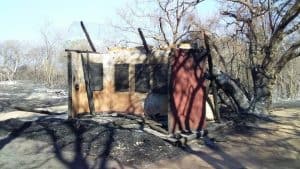 | 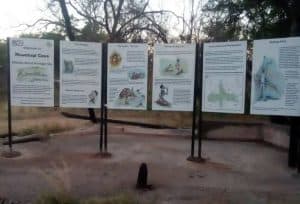 |
| The ruined site museum | New Information Panels |
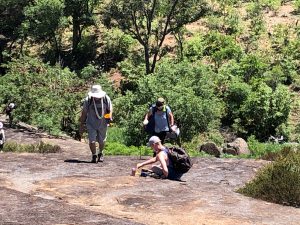 |  |
| Repainting the arrows leading to Inange Cave | Inange Cave Directional markings |

